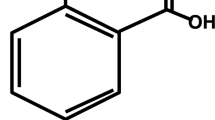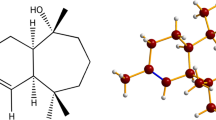Abstract
Guibourtia ehie (A. Chev.).Léonard (leguminosae), is a forest tree of Africa used traditionally for tumours, wound cleansing and diarrhoea. However, some of these ethnomedical uses have not been validated scientifically. The present study aimed at investigating the anti-inflammatory, antioxidant and cytotoxic effects of the plant extract. The study further evaluates the contribution of its metabolite 7,4′-dihydroxyflavone to these effects. Anti-inflammatory activity of the 70% ethanol extract of the stem bark of G. ehie was established using the carrageenan induced foot oedema in 7-day-old chicks at 30–100 mg/kg body weight with diclofenac as reference drug. The DPPH radical scavenging activity was used for the antioxidant test whereas cytotoxic effect was done using prostate cancer (PC-3) and breast cancer (MC-7) cell lines with MTT as a measure of cell viability. In silico analysis of the pharmacokinetics and toxicity of the compound isolated from the plant was also performed. The extract and reference drug diclofenac inhibited foot pad oedema by 28.58% and 61.99% respectively over the 5-hour period. The isolate showed a marginally higher activity than the extract (32.64%). The extract was cytotoxic against breast (MC-7) and prostate (PC-3) cancer cell lines with respective IC50 values of 67.43 and 61.12 µg/mL but showed poor selectivity index (SI < 2). The isolate 7,4′-dihydroxyflavone was non-cytotoxic and this was also confirmed from the in-silico studies. G. ehie and its isolate exhibit anti-inflammatory and antioxidant effect as suggested by folklore medicine. The extract was cytotoxic to breast and prostate cancer cell lines but was nonselective.






Similar content being viewed by others
Abbreviations
- MCP-2:
-
Monocyte chemotactic protein-2
- MCP-3:
-
Monocyte chemotactic protein-3
- iNOS:
-
intracellular nitric oxide synthase
- COX-2:
-
Cyclooxygenase-2
- VEGF:
-
Vascular endothelial growth factor receptor 1
- TNF-α:
-
Tumour necrosis Factor-α
- IL:
-
Interleukin
- B-NGF:
-
Beta-nerve growth factor
- mPGES-1:
-
Microsomal PGE-2 synthase-1
- PGE:
-
Prostaglandin E
References
Chen L, Deng H, Cui H et al (2017) Inflammatory responses and inflammation-associated diseases in organs. Oncotarget 9(6):7204–7218. https://doi.org/10.18632/oncotarget.23208
Eming SA, Wynn TA, Martin P (2017) Inflammation and metabolism in tissue repair and regeneration. Science 356(6342):1026–1030
Rajendran P, Chen YF, Chen YF et al (2018) The multifaceted link between inflammation and human diseases. J Cell Physiol 233(9):6458–6471. doi: https://doi.org/10.1002/jcp.26479
Furman D, Campisi J, Verdin E et al (2019) Chronic inflammation in the etiology of disease across the life span. Nat Med 25:1822–1832. https://doi.org/10.1038/s41591-019-0675-0
Vaidya FU, Chhipa AS, Sagar N et al (2020) Oxidative stress and inflammation can fuel cancer. In: Maurya P, Dua K (eds) Role of oxidative stress in pathophysiology of diseases. Springer, Singapore, pp 229–258. https://doi.org/10.1007/978-981-15-1568-2_14
Guzman JD, Evangelopoulos D, Gupta A et al (2013) Antitubercular specific activity of ibuprofen and the other 2-arylpropanoic acids using the HT-SPOTi whole-cell phenotypic assay. BMJ Open 3:e002672
Gold B, Pingle M, Brickner SJ et al (2012) Nonsteroidal anti-inflammatory drug sensitizes mycobacterium tuberculosis to endogenous and exogenous antimicrobials. Proc Natl Acad Sci 109:16004–16011
Arundhati M, Sadé B, Monisha S et al (2016) Repurposing drugs for treatment of tuberculosis: a role for non-steroidal anti-inflammatory drugs. Br Med Bull 118(1):138–148. https://doi.org/10.1093/bmb/ldw019
Kottoor SJ, Arora RR (2018) The utility of anti-inflammatory agents in cardiovascular disease: a novel perspective on the treatment of atherosclerosis. J Cardiovasc Pharmacol Therap. https://doi.org/10.1177/1074248418778548
Zappavigna S, Cossu AM, Grimaldi A et al (2020) Anti-inflammatory drugs as anticancer agents. Int J Mol Sci 21(7):2605. https://doi.org/10.3390/ijms21072605
Sarkodie JA, Debrah P, Kitcher C et al (2019) Glucose-lowering effect and anti-inflammatory activity of aqueous leaf extract of Taraxacum officinale in wistar rats. Int J Pharmacog Phytol Res 11(4):250–258
Patrice NK, Martial DJ, Bruno TP (2017) Is it a supplementary benefit to use anti-inflammatory agents in the treatment of type 2 diabetes? BMC Res Notes 10:471
Atanasov AG, Zotchev SB, Dirsch VM et al (2021) Natural products in drug discovery: advances and opportunities. Nat Rev Drug Discov 20(3):200–216
Newman DJ, Cragg GM (2020) “Natural products as sources of new drugs over the nearly four decades from 01/1981 to 09/2019. J Nat Prod 83(3):770–803. https://doi.org/10.1021/acs.jnatprod.9b01285
Obame-Engonga LC, Abdoul-Latif-Fatouma M, Engonga M et al (2017) Phytochemical screening, antioxidant and antibacterial activities of Guibourtia ehie and Syzygium rowlandii. Int J Current Res 9(08):56354–56360
Hall JB, Swaine MD (1981) Distribution and ecology of vascular plants in a tropical rain forest. For Veg Ghana. https://doi.org/10.1007/978-94-009-8650-3
Hawthorne WD (1995) Ecological profiles of Ghanaian forest trees. University of Oxford, Oxford Forestry Institute
Oteng-Amoako AA, Essien C, Lemmens RHMJ et al (2011) Guibourtia ehie PROTA. Plant Resources of Tropical Africa / Ressources végétales de l’Afrique tropicale)
Roux D (1951) Flavan-3.4-diols and Leuco-anthocyanidins of Guibourtia spp. Nature 183:890–891. https://doi.org/10.1038/183890a0
NIH (1985) “Department of Health Services”, Publication number: 23–83
Borquaye LS, Doetse MS, Baah SO et al (2020) Anti-inflammatory and anti-oxidant activities of ethanolic extracts of Tamarindus indica L.(Fabaceae). Cogent Chem 6(1):1743403
Ramos GF, Amponsah IK, Harley BK et al (2021) Triterpenoids mediate the antimicrobial, antioxidant, and anti-inflammatory activities of the stem bark of Reissantia indica. J Appl Pharma Sc 11(05):039–048
Govindappa M, Sadananda T, Channabasava R et al (2011) In vitro anti-inflammatory, lipoxygenase, xanthine oxidase and acetycholinesterase inhibitory activity of Tecoma stans (L.) Juss. Ex Kunth. Int J Pharma Bio Sci; 2:275–285
Appiah-Opong R, Asante IK, Safo DO et al (2016) Cytotoxic effects of Albizia zygia (DC) JF Macbr, a Ghanaian medicinal plant, against human T-lymphoblast-like leukemia, prostate and breast cancer cell lines. Int J Pharm Pharm Sci 8:392–396
Languon S, Tuffour I, Quayson EE et al (2018) In vitro evaluation of cytotoxic activities of marketed herbal products in Ghana. J Evid-based Integr Med. https://doi.org/10.1177/2515690×18790723
Armah FA, Amponsah IK, Mensah AY et al (2018) Leishmanicidal activity of the root bark of Erythrophleum ivorense (Fabaceae) and identification of some of its compounds by ultra-performance liquid chromatography quadrupole time of flight mass spectrometry (UPLC-QTOF-MS/MS). J Ethnopharmacol 211:207–216. https://doi.org/10.1016/j.jep.2017.09.030
Wang Y, Shen SY, Liu L et al (2022) Jolkinolide B inhibits proliferation or migration and promotes apoptosis of MCF-7 or BT-474 breast cancer cells by downregulating the PI3K-Akt pathway. J Ethnopharmacol 282:114581. https://doi.org/10.1016/j.jep.2021.114581
Dallakyan S, Olson AJ (2015) Small-molecule library screening by docking with PyRx, in chemical biology. Springer, pp 243–250
Yang H, Lou C, Sun L et al (2019) admetSAR 2.0: web-service for prediction and optimization of chemical ADMET properties. Bioinformatics 35(6):1067–1069
Dong J, Wang NN, Yao ZJ et al (2018) ADMETlab: a platform for systematic ADMET evaluation based on a comprehensively collected ADMET database. J Cheminform 10(1):29
Harley BK, Dickson RA, Amponsah IK et al (2020) Flavanols and triterpenoids from Myrianthus arboreus ameliorate hyperglycaemia in streptozotocin-induced diabetic rats possibly via glucose uptake enhancement and α-amylase inhibition. Biomed Pharmacother 132:110847
de Bruyn Kops C, Stork C, Šícho M et al (2019) GLORY: generator of the structures of likely cytochrome P450 metabolites based on predicted sites of metabolism. Front chem 7:402
Sutradhar RK, Rahman AM, Ahmad MU et al (2008) Bioactive flavones of Sida cordifolia. Phytochem Lett 1(4):179–182
Mabry T, Markham KR, Thomas MB (2012) The systematic identification of flavonoids. Springer Sci & Business Media
Jayaprakasam B, Doddaga S, Wang R et al (2009) Licorice flavonoids inhibit eotaxin-1 secretion by human fetal lung fibroblasts in vitro. J Agric Food Chem 57(3):820–825
Liu C, Weir D, Busse P et al (2015) The flavonoid 7, 4′-dihydroxyflavone inhibits MUC5AC gene expression, production, and secretion via regulation of NF‐κB, STAT6, and HDAC2. Phyto Res 29(6):925–932
Park Y, Moon BH, Lee E et al (2007) 1H and 13 C-NMR data of hydroxyflavone derivatives. Mag Res Chem 45(8):674–679
Hunter P (2012) The inflammation theory of disease. The growing realization that chronic inflammation is crucial in many diseases opens new avenues for treatment. EMBO Rep 13(11):968–970. https://doi.org/10.1038/embor.2012.142
Annamalai P, Thangam P EB (2017) Local and systemic profiles of inflammatory cytokines in carrageenan-induced paw inflammation in rats. Immunol Investig 46(3):274–283
Han Y, Yang J, Fang J et al (2022) The secretion profile of mesenchymal stem cells and potential applications in treating human diseases. Signal Transduct Target Ther 7(1):1–9. https://doi.org/10.1038/s41392-022-00932-0
Li YY, Huang SS, Lee MM et al (2015) Anti-inflammatory activities of cardamonin from Alpinia katsumadai through heme oxygenase-1 induction and inhibition of NF-κB and MAPK signaling pathway in the carrageenan-induced paw edema. Int Immunopharmacol 25(2):332–339
Zhang H, Shang C, Tian Z et al (2020) Diallyl disulfide suppresses inflammatory and oxidative machineries following carrageenan injection-induced paw edema in mice. Mediators Inflamm. https://doi.org/10.1155/2020/8508906
Han X, Zhu S, Wang B et al (2014) Antioxidant action of 7, 8-dihydroxyflavone protects PC12 cells against 6-hydroxydopamine-induced cytotoxicity. Neurochem Int 1(64):18–23
Wojnar W, Zych M, Borymski S et al (2020) Kaczmarczyk-Sedlak I. Chrysin reduces oxidative stress but does not affect polyol pathway in the lenses of type 1 diabetic rats. Antioxidants (Basel) 9(2):160. https://doi.org/10.3390/antiox9020160
Mittal M, Siddiqui MR, Tran K et al (2014) Reactive oxygen species in inflammation and tissue injury. Antioxid Redox Signal 20(7):1126–1167. https://doi.org/10.1089/ars.2012.5149
Taucher E, Mykoliuk I, Fediuk M et al (2022) Autophagy, oxidative stress and cancer development. Cancers 14(7):1637. https://doi.org/10.3390/cancers14071637
Defo Deeh PB, Watcho P, Wankeu-Nya M et al (2019) The methanolic extract of Guibourtia tessmannii (caesalpiniaceae) and selenium modulate cytosolic calcium accumulation, apoptosis and oxidative stress in R2C tumour Leydig cells: involvement of TRPV1 channels. Andrologia 51(3):e13216. https://doi.org/10.1111/and.13216
Harley BK, Amponsah IK, Ben IO et al (2021) Myrianthus libericus: possible mechanisms of hypoglycaemic action and in silico prediction of pharmacokinetics and toxicity profile of its bioactive metabolite, friedelan-3-one. Biomed Pharmacol 137:111379
Acknowledgements
Authors are indebted to technical staff of the Departments of Pharmacognosy, Pharmacology (KNUST), Department of Pharmacognosy and Herbal Medicine, University of Ghana School of Pharmacy and University of Health and Allied sciences. Technical staff of Noguchi Memorial Institute for Medical Research are also duly acknowledged. We are also grateful to technical staff of INFU, Dortmund technical University, Germany, for the assistance with spectroscopic data.
Author information
Authors and Affiliations
Corresponding author
Ethics declarations
Conflict of interest
All the Authors state there is no conflict of interest.
Additional information
Publisher’s note
Springer Nature remains neutral with regard to jurisdictional claims in published maps and institutional affiliations.
Supplementary Information
Below is the link to the electronic supplementary material.
Rights and permissions
About this article
Cite this article
Amponsah, I.K., Ramos, G.F., Harley, B.K. et al. Anti-inflammatory, Antioxidant and Cytotoxic Activities of Guibourtia ehie on Human Prostate (PC-3) and Breast Cancer (MC-7) Cell Lines and in silico Studies on Its Metabolite 7,4′-Dihydroxyflavone. Chemistry Africa 5, 627–639 (2022). https://doi.org/10.1007/s42250-022-00359-8
Received:
Accepted:
Published:
Issue Date:
DOI: https://doi.org/10.1007/s42250-022-00359-8




